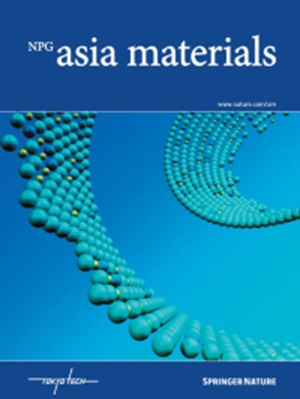Structure-dynamics relation in metallic glass revealed by 5-dimensional scanning transmission electron microscopy
IF 8.3
2区 材料科学
Q1 MATERIALS SCIENCE, MULTIDISCIPLINARY
引用次数: 0
Abstract
Dynamical and structural heterogeneities play an important role in glass transition phenomena. However, the relation between these heterogeneities is not fully revealed. In this study, we simultaneously observed these heterogeneities near the glass transition temperature in Zr50Cu40Al10 using five-dimensional scanning transmission electron microscopy, which can record the spatiotemporal distribution of diffraction patterns. The heterogeneities were visualized with sub-nanometer resolution, and a correlation between them was measured up to the glass transition temperature. We verified that ordered structures had slow dynamics, and the order decreased as the temperature increased. Dynamical and structural heterogeneities play important roles in glass transition. However, the relationship between these heterogeneities has not been fully revealed. In this study, we simultaneously observed these heterogeneities near the glass transition temperature in Zr50Cu40Al10 via five-dimensional scanning transmission electron microscopy (5D-STEM), which can record the spatiotemporal distribution of diffraction patterns. We estimated local dynamics from the temporal series of diffraction patterns and local structural orders from the diffraction patterns themselves. By performing this estimation for all scanning points, we visualized the heterogeneities and found the correlation between them, which indicated that ordered structures tended to have slow dynamics.

金属玻璃的五维扫描透射电镜结构动力学关系研究
动力学和结构的非均质性在玻璃化转变现象中起着重要作用。然而,这些异质性之间的关系并没有完全揭示出来。在本研究中,我们使用五维扫描透射电镜同时观察了Zr50Cu40Al10在玻璃化转变温度附近的这些非均质性,可以记录衍射图样的时空分布。在亚纳米分辨率下显示了非均质性,并测量了它们之间的相关性,直至玻璃化转变温度。我们验证了有序结构具有缓慢的动力学,并且随着温度的升高有序度降低。动力学非均质性和结构非均质性在玻璃化转变中起重要作用。然而,这些异质性之间的关系尚未完全揭示。在本研究中,我们通过五维扫描透射电镜(5D-STEM)同时观察了Zr50Cu40Al10在玻璃化转变温度附近的这些非均质性,可以记录衍射图样的时空分布。我们从衍射图的时间序列估计局部动力学,从衍射图本身估计局部结构顺序。通过对所有扫描点进行这种估计,我们可视化了异质性,并发现了它们之间的相关性,这表明有序结构往往具有缓慢的动力学。
本文章由计算机程序翻译,如有差异,请以英文原文为准。
求助全文
约1分钟内获得全文
求助全文
来源期刊

Npg Asia Materials
MATERIALS SCIENCE, MULTIDISCIPLINARY-
CiteScore
15.40
自引率
1.00%
发文量
87
审稿时长
2 months
期刊介绍:
NPG Asia Materials is an open access, international journal that publishes peer-reviewed review and primary research articles in the field of materials sciences. The journal has a global outlook and reach, with a base in the Asia-Pacific region to reflect the significant and growing output of materials research from this area. The target audience for NPG Asia Materials is scientists and researchers involved in materials research, covering a wide range of disciplines including physical and chemical sciences, biotechnology, and nanotechnology. The journal particularly welcomes high-quality articles from rapidly advancing areas that bridge the gap between materials science and engineering, as well as the classical disciplines of physics, chemistry, and biology. NPG Asia Materials is abstracted/indexed in Journal Citation Reports/Science Edition Web of Knowledge, Google Scholar, Chemical Abstract Services, Scopus, Ulrichsweb (ProQuest), and Scirus.
 求助内容:
求助内容: 应助结果提醒方式:
应助结果提醒方式:


